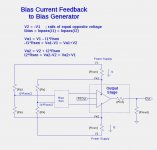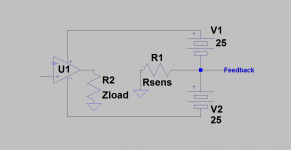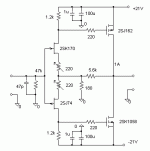Here is another potential benefit of the topology in the previous post. The bias current can be sensed on either rail and inserted into the output stage bias generator to reduce thermal drift. Either one or both of the -I1*Rsen/2 and I2*Rsen/2 voltages can be used by the bias generator. In the diagram below, it is assumed that the bias generator applies a lopass filter on the feedback signals.
Attachments
Member
Joined 2009
Paid Member
Positive feedback from finite resistance in power rail - isn't this the origin of the so-called motor-boat distortion ?
Positive feedback from finite resistance in power rail - isn't this the origin of the so-called motor-boat distortion ?
Positive feedback? I think not. The intent is to provide negative feedback to the bias generator. As with any negative feedback scheme, one must be careful about the phase delays in the circuit to prevent a negative feedback signal from becoming positive feedback.
Here is an interesting PCF topology that avoids disturbing the input path to the amplifier by generating a PCF feedback current that is of the opposite phase of that generated by having a sense resistor in the path of the amplifier load as in the Type-1 and Type-2 typologies that I have previously described. This topology assumes that the V+ and V- power rails have equal opposite voltages. A sense resistor is placed in the path between each rail and the output stage. The figure on the left shows show the load current feedback is generated by summing the voltages on the amplifier end of the sense resistors. The figure on the right shows the analysis of the complete feedback circuit and how to compute the resistor values.
Hello lhquam. The attached schematic shows a simple approach to derive a feedback signal across a sense resistor via the voltage rails of the power output stage. This schematic is like that previously shown in post #696 for the power output stage; except the location of the load and sense resistors are reversed.
Attachments
Yes, that would work, but it requires that the power supply float.Hello lhquam. The attached schematic shows a simple approach to derive a feedback signal across a sense resistor via the voltage rails of the power output stage. This schematic is like that previously shown in post #696 for the power output stage; except the location of the load and sense resistors are reversed.
bra,
The F7 is still in production. You will probably have to wait a few years until it gets discontinued.
The F7 is still in production. You will probably have to wait a few years until it gets discontinued.
Papa has to have some secrets!but why, why, why 🙂 🙂 🙂
Look at it this way, you can live happily with the F6 or the VFET or whatever for some years. If those are good enough in 2016, they are just as good in 2018 or 2019. But then maybe the F8 or the Yamaha Commemorative (I just came up with it - don't ask) are available for purchase, and presumably better than the F7. But then the F7's circuit diagram is also published. Then you can beg for the F8 circuit diagram.
But I guess you understood the concept already. It is perfectly OK to cry out "why!"
I am to stupied to build it without schematic 🙂 But I must say that I was thinking a long time ago that circuit like F7 should sounds good 🙂 but in practice every point matters.....
There are schematics here that will work. What you will not see is the
schematic labeled "Official F7", and the reason for that is that it's a total
invitation to the commercial cloners who appear to want the "genuine"
article to promote ripoff sales.
schematic labeled "Official F7", and the reason for that is that it's a total
invitation to the commercial cloners who appear to want the "genuine"
article to promote ripoff sales.
Nelson we all appreciate your explanation, but I honestly think you did not have to do it. You do for the community so much, not many others (if any) share and educate us. There is indeed enough information around, one just has to be willing to "listen". Thank you again for all you do! 🙂
- Home
- Amplifiers
- Pass Labs
- First Watt F7 review



